Critical Reflection: Ethics and Governance in Organizations (BUSM3115)
VerifiedAdded on 2022/08/14
|6
|1430
|14
Report
AI Summary
This report provides a critical reflection on four articles concerning ethical decision-making in organizations: Gioia (1992), Jones and Ryan (1998), Monahan and Quinn (2006), and Sonenshein (2007). The report analyzes and contrasts these articles, exploring various perspectives on what constitutes ethical decision-making and the factors that influence it. The author discusses the different views of ethical decision-making, including scripted decision-making, the balance of justice, rights, and utilitarianism, and the importance of moral judgment and schemata. The report highlights the similarities and differences in the readings, particularly emphasizing organizational factors and the role of intrinsic and extrinsic factors in influencing ethical decisions. The author concludes by supporting Monahan and Quinn's perspective, which emphasizes balancing justice, rights, and utilitarianism as the best approach to ethical decision-making. The report stresses the significance of ethical decision-making in building trust and guiding organizational conduct.
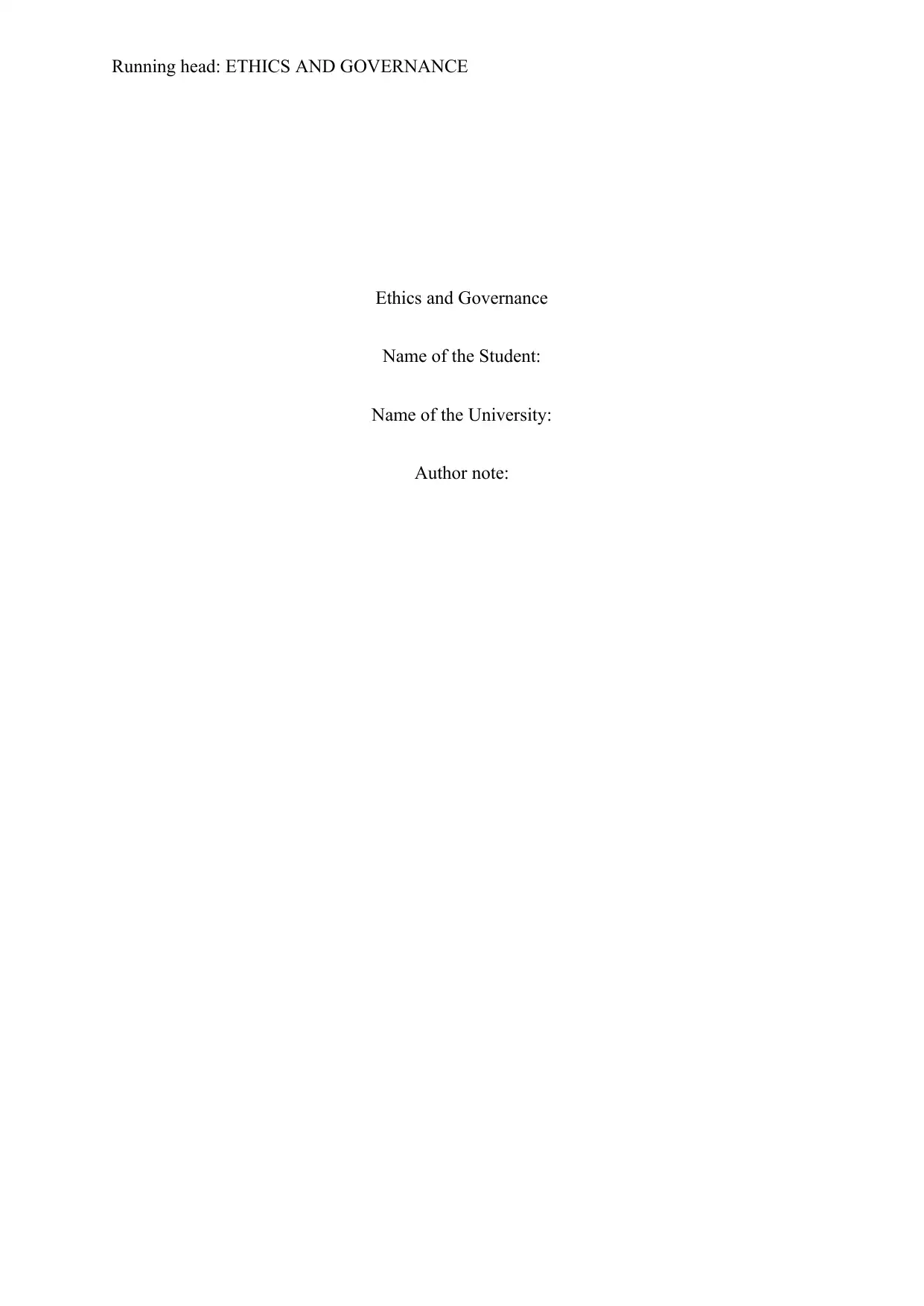
Running head: ETHICS AND GOVERNANCE
Ethics and Governance
Name of the Student:
Name of the University:
Author note:
Ethics and Governance
Name of the Student:
Name of the University:
Author note:
Paraphrase This Document
Need a fresh take? Get an instant paraphrase of this document with our AI Paraphraser
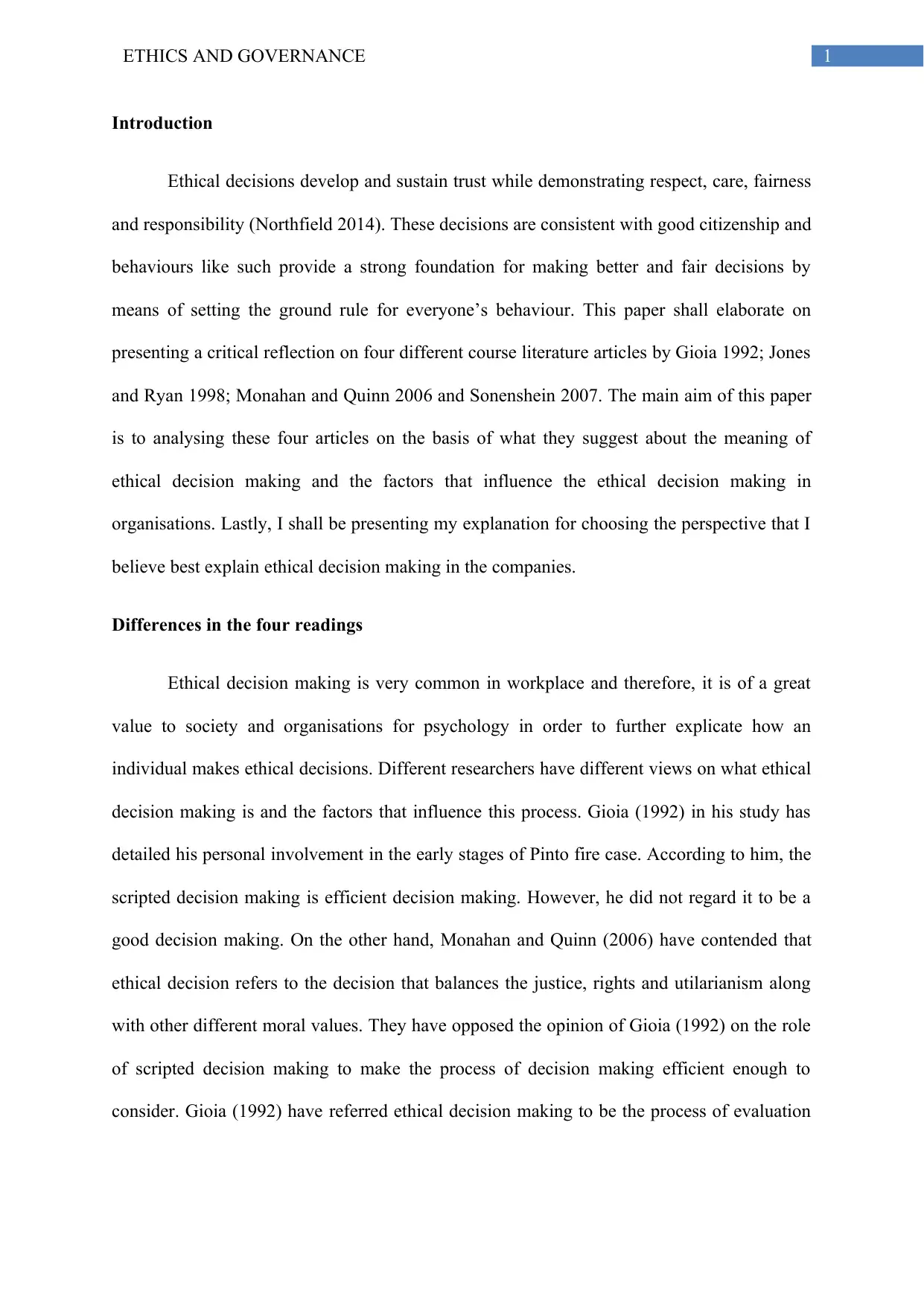
1ETHICS AND GOVERNANCE
Introduction
Ethical decisions develop and sustain trust while demonstrating respect, care, fairness
and responsibility (Northfield 2014). These decisions are consistent with good citizenship and
behaviours like such provide a strong foundation for making better and fair decisions by
means of setting the ground rule for everyone’s behaviour. This paper shall elaborate on
presenting a critical reflection on four different course literature articles by Gioia 1992; Jones
and Ryan 1998; Monahan and Quinn 2006 and Sonenshein 2007. The main aim of this paper
is to analysing these four articles on the basis of what they suggest about the meaning of
ethical decision making and the factors that influence the ethical decision making in
organisations. Lastly, I shall be presenting my explanation for choosing the perspective that I
believe best explain ethical decision making in the companies.
Differences in the four readings
Ethical decision making is very common in workplace and therefore, it is of a great
value to society and organisations for psychology in order to further explicate how an
individual makes ethical decisions. Different researchers have different views on what ethical
decision making is and the factors that influence this process. Gioia (1992) in his study has
detailed his personal involvement in the early stages of Pinto fire case. According to him, the
scripted decision making is efficient decision making. However, he did not regard it to be a
good decision making. On the other hand, Monahan and Quinn (2006) have contended that
ethical decision refers to the decision that balances the justice, rights and utilarianism along
with other different moral values. They have opposed the opinion of Gioia (1992) on the role
of scripted decision making to make the process of decision making efficient enough to
consider. Gioia (1992) have referred ethical decision making to be the process of evaluation
Introduction
Ethical decisions develop and sustain trust while demonstrating respect, care, fairness
and responsibility (Northfield 2014). These decisions are consistent with good citizenship and
behaviours like such provide a strong foundation for making better and fair decisions by
means of setting the ground rule for everyone’s behaviour. This paper shall elaborate on
presenting a critical reflection on four different course literature articles by Gioia 1992; Jones
and Ryan 1998; Monahan and Quinn 2006 and Sonenshein 2007. The main aim of this paper
is to analysing these four articles on the basis of what they suggest about the meaning of
ethical decision making and the factors that influence the ethical decision making in
organisations. Lastly, I shall be presenting my explanation for choosing the perspective that I
believe best explain ethical decision making in the companies.
Differences in the four readings
Ethical decision making is very common in workplace and therefore, it is of a great
value to society and organisations for psychology in order to further explicate how an
individual makes ethical decisions. Different researchers have different views on what ethical
decision making is and the factors that influence this process. Gioia (1992) in his study has
detailed his personal involvement in the early stages of Pinto fire case. According to him, the
scripted decision making is efficient decision making. However, he did not regard it to be a
good decision making. On the other hand, Monahan and Quinn (2006) have contended that
ethical decision refers to the decision that balances the justice, rights and utilarianism along
with other different moral values. They have opposed the opinion of Gioia (1992) on the role
of scripted decision making to make the process of decision making efficient enough to
consider. Gioia (1992) have referred ethical decision making to be the process of evaluation
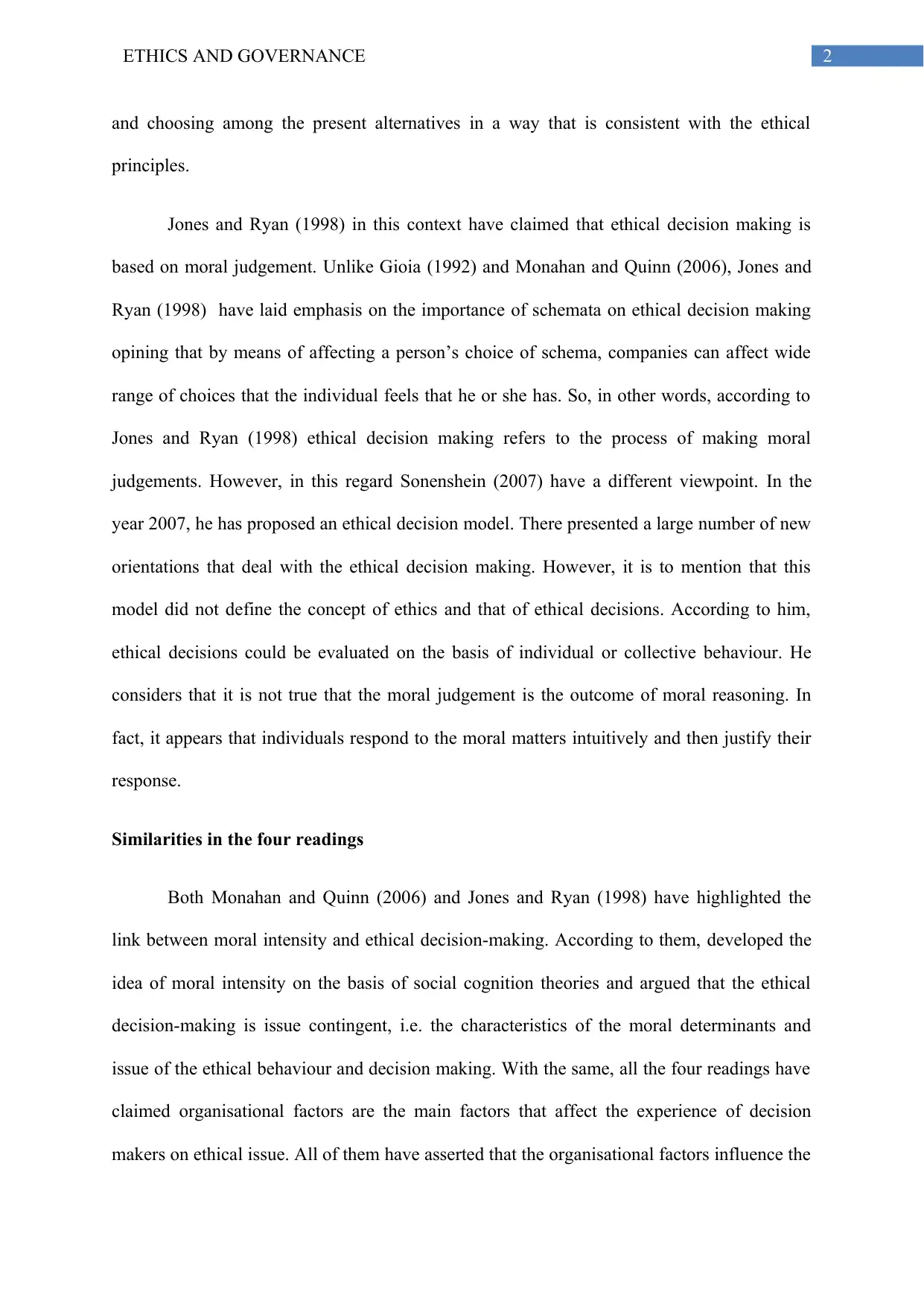
2ETHICS AND GOVERNANCE
and choosing among the present alternatives in a way that is consistent with the ethical
principles.
Jones and Ryan (1998) in this context have claimed that ethical decision making is
based on moral judgement. Unlike Gioia (1992) and Monahan and Quinn (2006), Jones and
Ryan (1998) have laid emphasis on the importance of schemata on ethical decision making
opining that by means of affecting a person’s choice of schema, companies can affect wide
range of choices that the individual feels that he or she has. So, in other words, according to
Jones and Ryan (1998) ethical decision making refers to the process of making moral
judgements. However, in this regard Sonenshein (2007) have a different viewpoint. In the
year 2007, he has proposed an ethical decision model. There presented a large number of new
orientations that deal with the ethical decision making. However, it is to mention that this
model did not define the concept of ethics and that of ethical decisions. According to him,
ethical decisions could be evaluated on the basis of individual or collective behaviour. He
considers that it is not true that the moral judgement is the outcome of moral reasoning. In
fact, it appears that individuals respond to the moral matters intuitively and then justify their
response.
Similarities in the four readings
Both Monahan and Quinn (2006) and Jones and Ryan (1998) have highlighted the
link between moral intensity and ethical decision-making. According to them, developed the
idea of moral intensity on the basis of social cognition theories and argued that the ethical
decision-making is issue contingent, i.e. the characteristics of the moral determinants and
issue of the ethical behaviour and decision making. With the same, all the four readings have
claimed organisational factors are the main factors that affect the experience of decision
makers on ethical issue. All of them have asserted that the organisational factors influence the
and choosing among the present alternatives in a way that is consistent with the ethical
principles.
Jones and Ryan (1998) in this context have claimed that ethical decision making is
based on moral judgement. Unlike Gioia (1992) and Monahan and Quinn (2006), Jones and
Ryan (1998) have laid emphasis on the importance of schemata on ethical decision making
opining that by means of affecting a person’s choice of schema, companies can affect wide
range of choices that the individual feels that he or she has. So, in other words, according to
Jones and Ryan (1998) ethical decision making refers to the process of making moral
judgements. However, in this regard Sonenshein (2007) have a different viewpoint. In the
year 2007, he has proposed an ethical decision model. There presented a large number of new
orientations that deal with the ethical decision making. However, it is to mention that this
model did not define the concept of ethics and that of ethical decisions. According to him,
ethical decisions could be evaluated on the basis of individual or collective behaviour. He
considers that it is not true that the moral judgement is the outcome of moral reasoning. In
fact, it appears that individuals respond to the moral matters intuitively and then justify their
response.
Similarities in the four readings
Both Monahan and Quinn (2006) and Jones and Ryan (1998) have highlighted the
link between moral intensity and ethical decision-making. According to them, developed the
idea of moral intensity on the basis of social cognition theories and argued that the ethical
decision-making is issue contingent, i.e. the characteristics of the moral determinants and
issue of the ethical behaviour and decision making. With the same, all the four readings have
claimed organisational factors are the main factors that affect the experience of decision
makers on ethical issue. All of them have asserted that the organisational factors influence the
⊘ This is a preview!⊘
Do you want full access?
Subscribe today to unlock all pages.

Trusted by 1+ million students worldwide
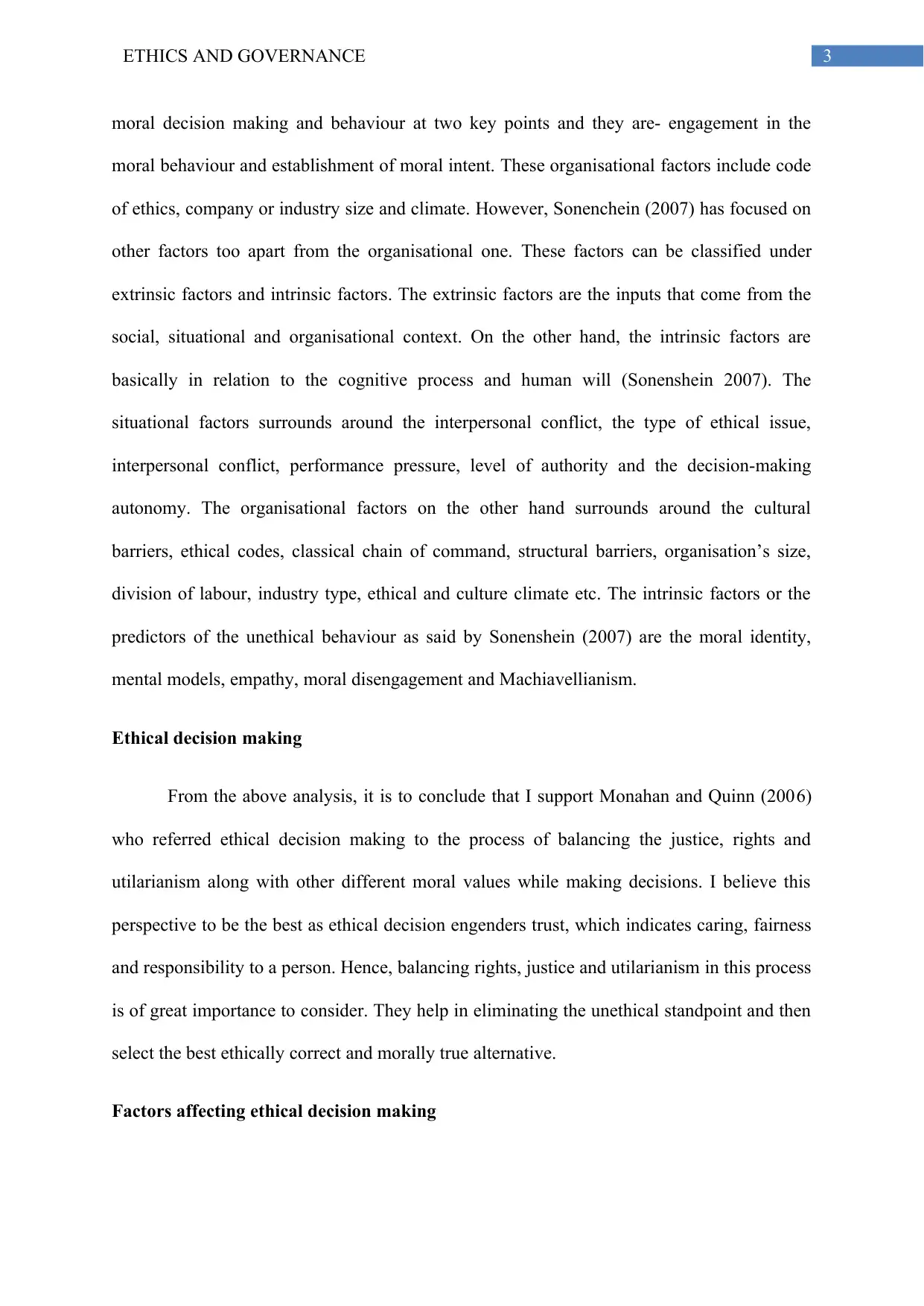
3ETHICS AND GOVERNANCE
moral decision making and behaviour at two key points and they are- engagement in the
moral behaviour and establishment of moral intent. These organisational factors include code
of ethics, company or industry size and climate. However, Sonenchein (2007) has focused on
other factors too apart from the organisational one. These factors can be classified under
extrinsic factors and intrinsic factors. The extrinsic factors are the inputs that come from the
social, situational and organisational context. On the other hand, the intrinsic factors are
basically in relation to the cognitive process and human will (Sonenshein 2007). The
situational factors surrounds around the interpersonal conflict, the type of ethical issue,
interpersonal conflict, performance pressure, level of authority and the decision-making
autonomy. The organisational factors on the other hand surrounds around the cultural
barriers, ethical codes, classical chain of command, structural barriers, organisation’s size,
division of labour, industry type, ethical and culture climate etc. The intrinsic factors or the
predictors of the unethical behaviour as said by Sonenshein (2007) are the moral identity,
mental models, empathy, moral disengagement and Machiavellianism.
Ethical decision making
From the above analysis, it is to conclude that I support Monahan and Quinn (2006)
who referred ethical decision making to the process of balancing the justice, rights and
utilarianism along with other different moral values while making decisions. I believe this
perspective to be the best as ethical decision engenders trust, which indicates caring, fairness
and responsibility to a person. Hence, balancing rights, justice and utilarianism in this process
is of great importance to consider. They help in eliminating the unethical standpoint and then
select the best ethically correct and morally true alternative.
Factors affecting ethical decision making
moral decision making and behaviour at two key points and they are- engagement in the
moral behaviour and establishment of moral intent. These organisational factors include code
of ethics, company or industry size and climate. However, Sonenchein (2007) has focused on
other factors too apart from the organisational one. These factors can be classified under
extrinsic factors and intrinsic factors. The extrinsic factors are the inputs that come from the
social, situational and organisational context. On the other hand, the intrinsic factors are
basically in relation to the cognitive process and human will (Sonenshein 2007). The
situational factors surrounds around the interpersonal conflict, the type of ethical issue,
interpersonal conflict, performance pressure, level of authority and the decision-making
autonomy. The organisational factors on the other hand surrounds around the cultural
barriers, ethical codes, classical chain of command, structural barriers, organisation’s size,
division of labour, industry type, ethical and culture climate etc. The intrinsic factors or the
predictors of the unethical behaviour as said by Sonenshein (2007) are the moral identity,
mental models, empathy, moral disengagement and Machiavellianism.
Ethical decision making
From the above analysis, it is to conclude that I support Monahan and Quinn (2006)
who referred ethical decision making to the process of balancing the justice, rights and
utilarianism along with other different moral values while making decisions. I believe this
perspective to be the best as ethical decision engenders trust, which indicates caring, fairness
and responsibility to a person. Hence, balancing rights, justice and utilarianism in this process
is of great importance to consider. They help in eliminating the unethical standpoint and then
select the best ethically correct and morally true alternative.
Factors affecting ethical decision making
Paraphrase This Document
Need a fresh take? Get an instant paraphrase of this document with our AI Paraphraser
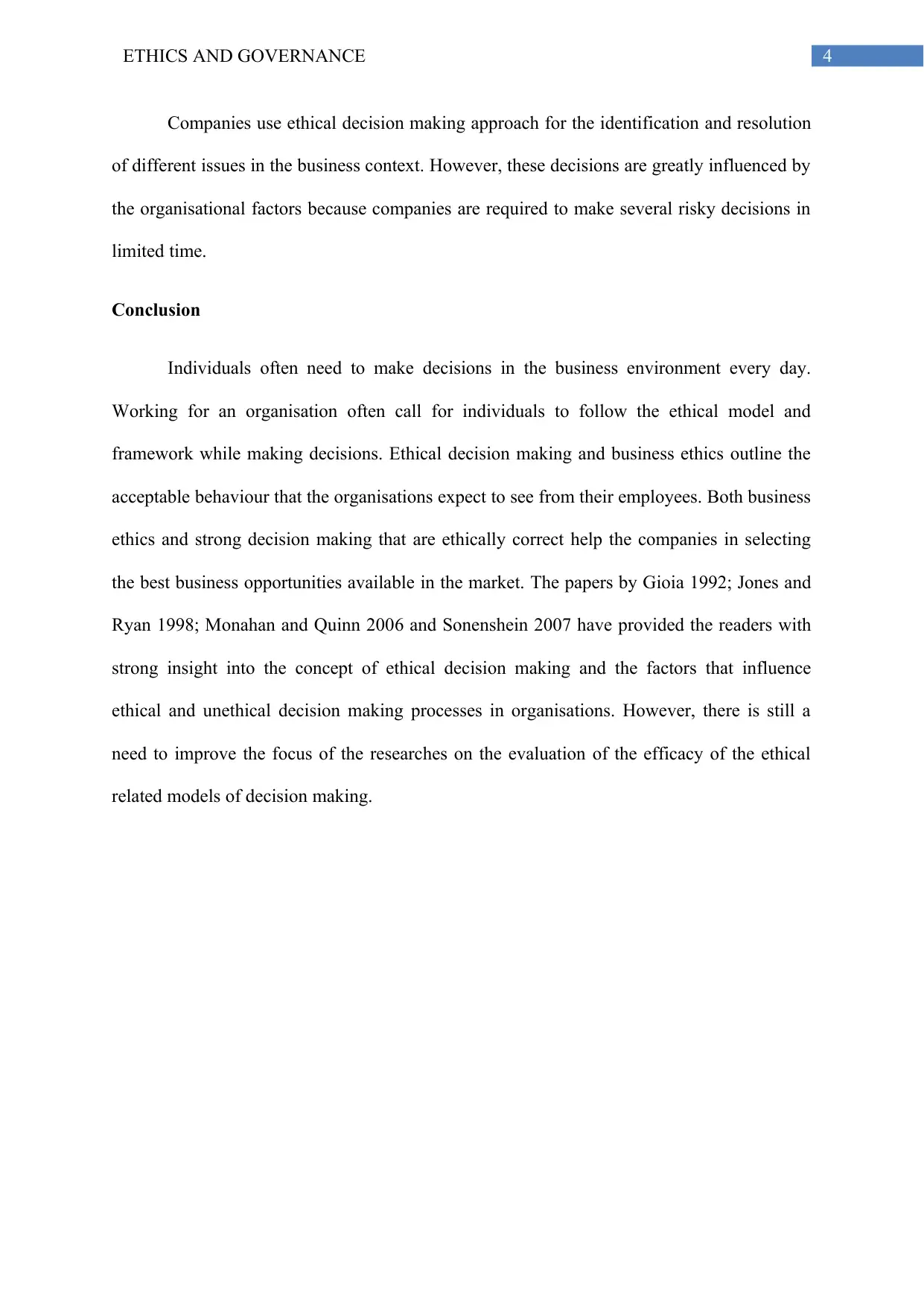
4ETHICS AND GOVERNANCE
Companies use ethical decision making approach for the identification and resolution
of different issues in the business context. However, these decisions are greatly influenced by
the organisational factors because companies are required to make several risky decisions in
limited time.
Conclusion
Individuals often need to make decisions in the business environment every day.
Working for an organisation often call for individuals to follow the ethical model and
framework while making decisions. Ethical decision making and business ethics outline the
acceptable behaviour that the organisations expect to see from their employees. Both business
ethics and strong decision making that are ethically correct help the companies in selecting
the best business opportunities available in the market. The papers by Gioia 1992; Jones and
Ryan 1998; Monahan and Quinn 2006 and Sonenshein 2007 have provided the readers with
strong insight into the concept of ethical decision making and the factors that influence
ethical and unethical decision making processes in organisations. However, there is still a
need to improve the focus of the researches on the evaluation of the efficacy of the ethical
related models of decision making.
Companies use ethical decision making approach for the identification and resolution
of different issues in the business context. However, these decisions are greatly influenced by
the organisational factors because companies are required to make several risky decisions in
limited time.
Conclusion
Individuals often need to make decisions in the business environment every day.
Working for an organisation often call for individuals to follow the ethical model and
framework while making decisions. Ethical decision making and business ethics outline the
acceptable behaviour that the organisations expect to see from their employees. Both business
ethics and strong decision making that are ethically correct help the companies in selecting
the best business opportunities available in the market. The papers by Gioia 1992; Jones and
Ryan 1998; Monahan and Quinn 2006 and Sonenshein 2007 have provided the readers with
strong insight into the concept of ethical decision making and the factors that influence
ethical and unethical decision making processes in organisations. However, there is still a
need to improve the focus of the researches on the evaluation of the efficacy of the ethical
related models of decision making.
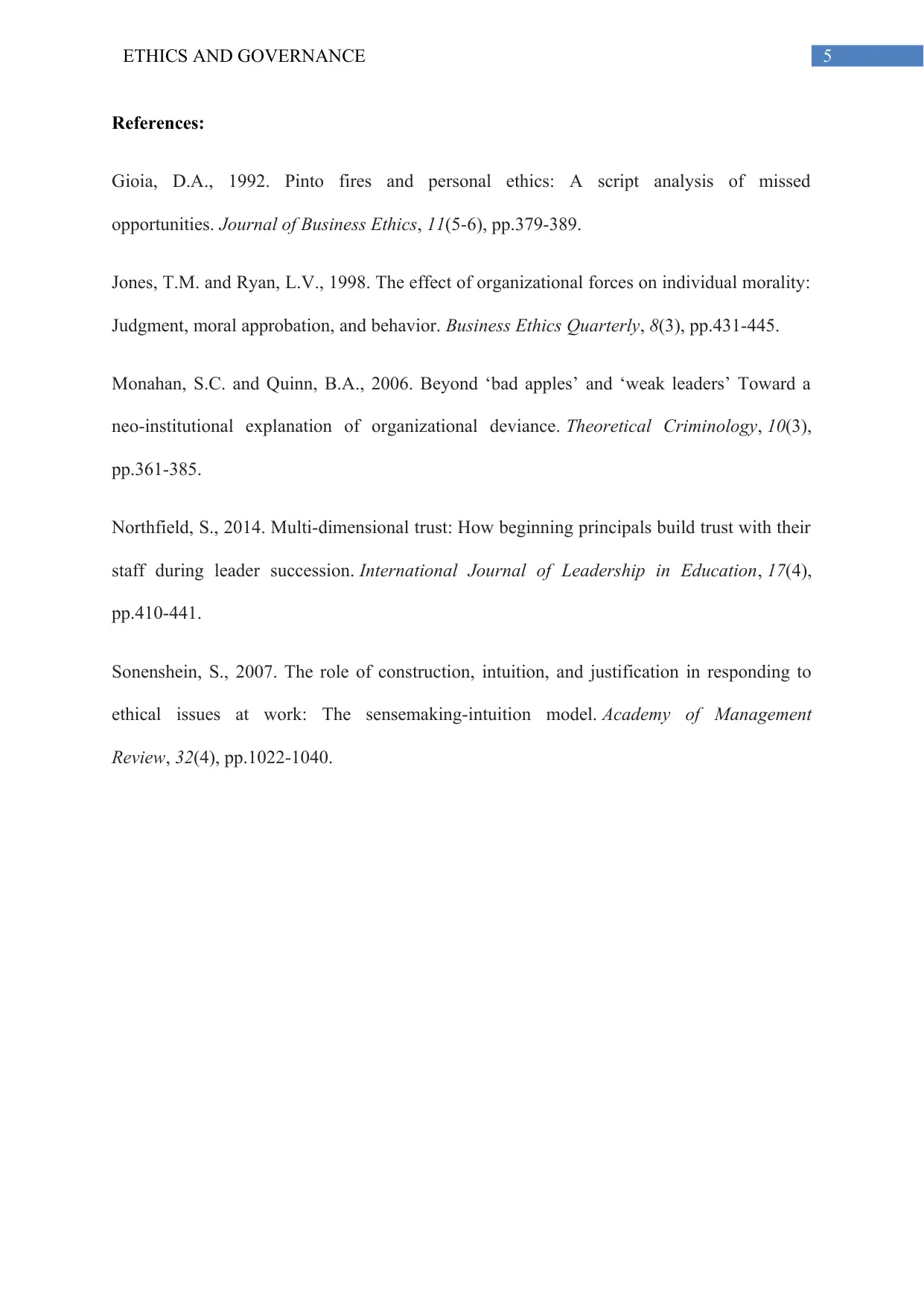
5ETHICS AND GOVERNANCE
References:
Gioia, D.A., 1992. Pinto fires and personal ethics: A script analysis of missed
opportunities. Journal of Business Ethics, 11(5-6), pp.379-389.
Jones, T.M. and Ryan, L.V., 1998. The effect of organizational forces on individual morality:
Judgment, moral approbation, and behavior. Business Ethics Quarterly, 8(3), pp.431-445.
Monahan, S.C. and Quinn, B.A., 2006. Beyond ‘bad apples’ and ‘weak leaders’ Toward a
neo-institutional explanation of organizational deviance. Theoretical Criminology, 10(3),
pp.361-385.
Northfield, S., 2014. Multi-dimensional trust: How beginning principals build trust with their
staff during leader succession. International Journal of Leadership in Education, 17(4),
pp.410-441.
Sonenshein, S., 2007. The role of construction, intuition, and justification in responding to
ethical issues at work: The sensemaking-intuition model. Academy of Management
Review, 32(4), pp.1022-1040.
References:
Gioia, D.A., 1992. Pinto fires and personal ethics: A script analysis of missed
opportunities. Journal of Business Ethics, 11(5-6), pp.379-389.
Jones, T.M. and Ryan, L.V., 1998. The effect of organizational forces on individual morality:
Judgment, moral approbation, and behavior. Business Ethics Quarterly, 8(3), pp.431-445.
Monahan, S.C. and Quinn, B.A., 2006. Beyond ‘bad apples’ and ‘weak leaders’ Toward a
neo-institutional explanation of organizational deviance. Theoretical Criminology, 10(3),
pp.361-385.
Northfield, S., 2014. Multi-dimensional trust: How beginning principals build trust with their
staff during leader succession. International Journal of Leadership in Education, 17(4),
pp.410-441.
Sonenshein, S., 2007. The role of construction, intuition, and justification in responding to
ethical issues at work: The sensemaking-intuition model. Academy of Management
Review, 32(4), pp.1022-1040.
⊘ This is a preview!⊘
Do you want full access?
Subscribe today to unlock all pages.

Trusted by 1+ million students worldwide
1 out of 6
Related Documents
Your All-in-One AI-Powered Toolkit for Academic Success.
+13062052269
info@desklib.com
Available 24*7 on WhatsApp / Email
![[object Object]](/_next/static/media/star-bottom.7253800d.svg)
Unlock your academic potential
Copyright © 2020–2025 A2Z Services. All Rights Reserved. Developed and managed by ZUCOL.





